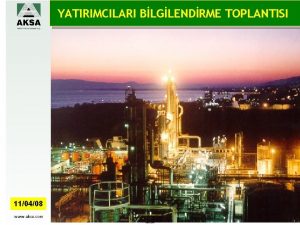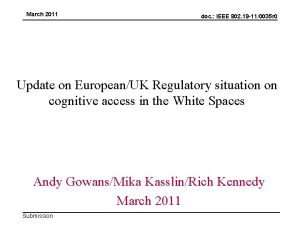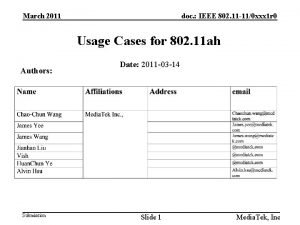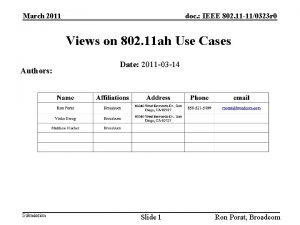March 2011 doc IEEE 802 11 110408 r








- Slides: 8

March 2011 doc. : IEEE 802. 11 -11/0408 r 2 Use Case Characteristics Discussion Date: 2011 -03 -15 Authors: Submission Slide 1 Tom Siep, CSR

March 2011 doc. : IEEE 802. 11 -11/0408 r 2 Abstract Discussion of concepts to be used to differentiate use case requirements. Submission Slide 2 Tom Siep, CSR

March 2011 doc. : IEEE 802. 11 -11/0408 r 2 Introductory Text (new slide) • The goal of this document is to assist in the process of turning use cases submitted to TGai into prototypical use cases. These prototypical use cases will then in turn be used to yield set of requirements that will be used to judge the utility of proposed text for 802. 11 ai. • Section 2 of this document is a summary all use cases presented to and accepted by TGai. The intent is to gather all use cases and group them into categories of similar traits. These combined use cases are the source for the prototypical use cases listed in Section 3. • Section 3 establishs a small set reference use cases for the purpose of evaluating proposals to TGai. It combines use cases which have the very similar requirements and is an abstracted use case rather than a specific scenario. Submission Slide 3 Tom Siep, CSR

March 2011 doc. : IEEE 802. 11 -11/0408 r 2 Definition of High, Medium, and Low • High = very difficult to achieve • Medium = difficult • Low = nominal behaviour, expected to be achieved with current technology Submission Slide 4 Tom Siep, CSR

March 2011 doc. : IEEE 802. 11 -11/0408 r 2 Link-Attempt Rate • Link-Attempt Rate is the number of STAs attempting to establish for the first time a link to an AP within an ESS as measured over a one second time interval. – High: more than 50 – Medium: 10 to 49 – Low: less than 10 • NOTE: Need to add paragraph to explain difference between LAR and Non-AP STA association rate as defined in clause 6. 13 of 802. 11. 2 Submission Slide 5 Tom Siep, CSR

March 2011 doc. : IEEE 802. 11 -11/0408 r 2 Media Load • Media Load is the “busyness” of the wireless medium of the ESS. It is measured as the percentage of time the medium is in use. – High: More than 50% – Medium: 10 to 50% – Low: Less than 10% • Use of “load” is adapted from the definition in IEEE 100 Submission Slide 6 Tom Siep, CSR

March 2011 doc. : IEEE 802. 11 -11/0408 r 2 Coverage Interval • Coverage Interval is the time the STA is within the range of an AP within an ESS. This time is the maximum available time for establishing a link and exchanging data. – High: less than 1 second – Medium: between 1 and 10 seconds – Low: more than 10 seconds Submission Slide 7 Tom Siep, CSR

March 2011 doc. : IEEE 802. 11 -11/0408 r 2 Link Setup Time is the amount time required to establish for the first time a link to an AP within an ESS. This includes the time for AP/Network discovery and Association and Authentication – High: less than 100 ms – Medium between 100 ms and 2 seconds – Low: more than 2 seconds • NOTE: – “link”, “association”, authentication are defined as per 802. 11 – We need to agree when to start measuring this time interval (e. g. when the STA enters the coverage of the ESS, etc. ) Submission Slide 8 Tom Siep, CSR














